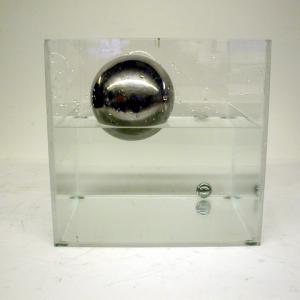College of Liberal Arts & Sciences
2B40.70 - Lifting Power of Balloons
Blow up balloons to the same diameter using different gases. Do not forget to add the mass of the string to your calculations.
Another example of this would be the two balls that have equal masses yet one floats and one does not due to different volumes.
- Jack Blumenthal, Rafaela Bradvica, and Katherine Karl, "Accurate Determination of the Volume of an Irregular Helium Balloon", TPT, Vol. 51, #2, Feb. 2013, p. 93.
- M. J. Clouter, "Archimedes' Principle: A Classroom Demonstration with a Twist", TPT, Vol. 44, #1, Jan. 2006, p. 46.
- Thomas J. Ritter Jr., "The Baker Street Irregulars Meet Archimedes", TPT, Vol. 43, #4, Apr. 2005, p. 226.
- David Keeports, "How Does the Potential Energy of a Rising Helium-Filled Balloon Change?", TPT, Vol. 40, #3, Mar. 2002, p. 164.
- Mark P. Silverman, "Flying High, Thinking Low? What Every Aeronaut Needs To Know", TPT, Vol. 36, #5, May 1998, p. 288.
- Joseph Miano, "Archimedes' Principle and Smiley-Faced Balloons", TPT, Vol. 33, #3, Mar. 1995, p. 172.
- Albert W. Burgstahler, Tom Wandless, and Clark E. Bricker, "The Relative Lifting Power of Hydrogen and Helium A Gas Buoyancy Demonstration Experiment", TPT, Vol. 25, #7, Oct. 1987, p. 434.
- Clyde J. Smith, "Archimedes’ Principle Meets Charles’ Law", TPT, Vol. 17, #3, Mar. 1979, p. 187, also A Potpourri of Physics Teaching Ideas - Heat and Fluids.
- Robert Ehrlich, "H.8. Hanging a Weight from a Helium-Filled Balloon", Turning the World Inside Out and 174 Other Simple Physics Demonstrations, p. 103 - 104.
- Carl Ahlers, "3. Hot Hydrogen Applications", Expose Excite Ignite an Essential to Whizz-Bang Chemistry.
- Herb Strongin, “Showing How Helium and Carbon Dioxide Balloons Behave Differently“, Science on a Shoestring, p. 130.
- Julius Sumner Miller, Q60 & A60, Millergrams I – Some Enchanting Questions for Enquiring Minds, p. 42 & 98.
- Julius Sumner Miller, Q202 & A202, Millergrams II – Some More Enchanting Questions for Enquiring Minds, p. 59 & 109.
Disclaimer: These demonstrations are provided only for illustrative use by persons affiliated with The University of Iowa and only under the direction of a trained instructor or physicist. The University of Iowa is not responsible for demonstrations performed by those using their own equipment or who choose to use this reference material for their own purpose. The demonstrations included here are within the public domain and can be found in materials contained in libraries, bookstores, and through electronic sources. Performing all or any portion of any of these demonstrations, with or without revisions not depicted here entails inherent risks. These risks include, without limitation, bodily injury (and possibly death), including risks to health that may be temporary or permanent and that may exacerbate a pre-existing medical condition; and property loss or damage. Anyone performing any part of these demonstrations, even with revisions, knowingly and voluntarily assumes all risks associated with them.

